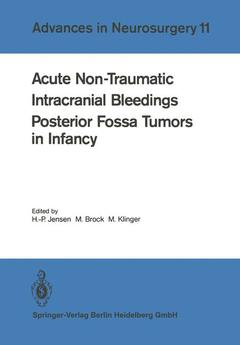Description
Acute Non-Traumatic Intracranial Bleedings. Posterior Fossa Tumors in Infancy, 1983
Advances in Neurosurgery Series, Vol. 11
Coordinators: Jensen H.-P., Brock Mario, Klinger M.
Language: English
Keywords
Hirnblutung; Hirngeschwulst; aneurysm; brain; brain tumor; microsurgery; neuropathology; neurosurgery; radiotherapy; surgery; trauma
Publication date: 10-1983
408 p. · 17x24.4 cm · Paperback
408 p. · 17x24.4 cm · Paperback
Description
/li>Contents
/li>
This volume of ADVANCES IN NEUROSURGERY presents the original texts of 60 papers delivered at the 33rd annual meeting of the German Neuro surgical Society held in Kiel from May 16th to 20th, 1982. These papers represent a selection from some 162 papers submitted and 96 actually given. The selection was made by the society's programme committee, of which Professor W. J. BOCK, Professor H. DIETZ and Professor W. GROTE are also members. I would like to take this opportunity to express my sincere thanks to them for their untiring cooperation. The scientific programme dealt with three main themes: 1. Acute, non-traumatic intracranial hemorrhages, a subject that has always been of importance for neurological surgeons since the ana tomist Giovanni Battista MORGAGNI in 1791 first described in detail the clinical picture and the pathological and anatomical causes of a brain hemorrhage he had observed in his servant. Indeed, at our 31st annual meeting in Erlangen in 1980 "Timing Problems in Sub arachnoid Hemorrhages" was one of the main topics of discussion. For this year's meeting a cooperative study in which 27 university and hospital departments of neurosurgery participated enabled us to look into the causes and the diagnostic and therapeutic measures involved in a great number of cases of intracranial hemorrhage.
The President’s Opening Remarks and Address to the Delegates of the 33rd Annual Congress of the German Neurosurgical Society.- Acute Non-Traumatic Intracranial Bleeding.- Acute, Non-Traumatic Intracranial Hemorrhage — Diagnosis and Timing.- Acute, Non-Traumatic Intracranial Hemorrhage — Treatment and Prognosis.- Acute, Non-Traumatic Intracranial Hemorrhage — Critical Remarks on the Results of the Cooperative Study.- Dynamic Multi-Plane CT in the Diagnosis of Intracranial Aneurysms.- Resolving Spontaneous Intracerebral Hematoma — Diagnostic Problems in Enhanced CT.- Differential Diagnosis and Resorption Behavior of Spontaneous Cerebral Hemorrhages in CT.- Familial Occurrence of Intracerebral Hematomas.- nrCBF for Timing of Angiography and Operation in Subarachnoid Hemorrhage.- An Angiographic Study of the Carotid Arterial Subarachnoid Hemorrhage.- Early Operations on Ruptured Aneurysms.- Correlation of Clinical Course, Angiography and CT in Patients After Subarachnoid Hemorrhage.- Spontaneous Intracranial Hemorrhage, Intracranial Pressure and Indications for Operation — A Clinical Follow-Up Study.- The Significance of the Size of an Intracerebral Hematoma for Treatment and Prognosis.- Clinical Course of 160 Operated and 45 Conservatively Treated Patients with Spontaneous Intracerebral Hematoma.- Value of CT Scan in the Prognosis of Spontaneous Intracerebral Hemorrhage into the Ventricular System.- Spontaneous Infratentorial Hematomas: CT and Angiographic Findings — Prognosis.- Acute Intracranial Hemorrhage Following Thrombosis of Cerebral Veins and Dural Sinuses.- Antifibrinolytic Therapy of Intracranial Hemorrhage with Tranexamic Acid.- The Long-Term Prognosis of Patients with Subarachnoid Hemorrhage.- Intracranial Bleedings Associated with AnticoagulantTherapy.- Long-Term ECG Investigation in Subarachnoid and Intracerebral Hemorrhage.- Perinatal Cerebral Hemorrhage: Morphology, Clinical Diagnosis, Treatment and Follow-Up.- Spontaneous Hemorrhages in Intracerebral Brain Tumors and Leukemia.- Follow-Up Observations in Spontaneous Brain Stem Hemorrhages.- Posterior Fossa Tumors in Infancy.- Clinical and Diagnostic Appearance of Tumors of the Posterior Fossa in Childhood, Results of a Retrospective Cooperative Study.- Posterior Fossa Tumors in Children — Treatment and Prognosis.- Critique of the Findings.- Age-Dependent Morphobiological Aspects of “Medulloblastomas”.- Immunohistology in Diagnostic Neuropathology.- Glial Fibrillary Acid Protein in Medulloblastomas.- The Value of Intraoperative Histological Examination in Order to Decide on the Surgical Procedure in Medulloblastomas and Astrocytomas of the Posterior Fossa.- Tumors of the Posterior Cranial Fossa in Childhood: Role of Radiotherapy and Chemotherapy.- The Importance of Fixation Supression in the Detection of Posterior Fossa Tumors.- The Importance of Neurophysiological Examination for Confirmation of the Diagnosis in Brain Stem Tumors in Children.- Early Auditory Evoked Potentials (EAEP) in Neurosurgery — A New Method for Diagnosis and Location of Posterior Fossa Tumors in Childhood.- Diagnostic Methods, Length of History and Survival Rate of Brain-Tumor Patients in Childhood Before and After the Introduction of CT.- Internal Shunt or Peri-Operative Pressure-Controlled Ventricular-Fluid Drainage (C-VFD) in Children and Juveniles with Infratentorial Tumors.- Schedule of Treatment for Pineal Tumors in Children.- Infratentorial-Supracerebellar Approach to the Pineal and Mesencephalic Region in Children.- Diagnosis and Treatment of Tumors of the PinealRegion, Posterior Third Ventricle and Quadrigeminal Plate. Present Value of the Stereotactic Exploration.- CT-Scanning for Long Term Follow-Ups After Microsurgery for Pediatric Tumors in the Posterior Fossa.- Long-Term Survival of Medulloblastomas.- Comparative’ Studies of Clinical Findings in Children and Adults with Tumors of the Posterior Fossa.- Diagnosis and Treatment of Cystic Non-Tumorous Lesions of the Posterior Fossa in Children.- Free Topics.- Effects of Dexamethasone on Physical and Biochemical Properties of the Normal Non-Edematous Brain.- Effect of Dexamethasone on Regional Cerebral Blood Flow in Patients with Cerebral Tumors and Brain Edema.- Determination of the Effect of Dexamethasone on Peritumoral Brain Edema.- Cerebral Oxygen Tension and Microcirculation in Barbiturate Treatment. An Experimental Investigation.- Barbiturate Effect on Intracranial Pressure After Experimental Cold Lesions.- Does Barbiturate “Mono-Therapy” Favorably Influence Brain Survival After Traumatic Coma?.- Caloric Stimulation Pattern in Traumatic Coma and Some rCBF Changed Induced by Caloric Vestibular Stimulation.- Early Management and Observations in Traumatic Coma. The Significance of Moderate Hyperventilation and the Occurrence of Sudden Blood Pressure Falls.- Effects of Bradykinin on Blood-Brain-Barrier Function and Pial Microcirculation.- Comparative Study of the Blood Flow Velocities in the Basilar and the Carotid Artery.- Intraoperative Doppler Flow Measurements in Cerebrovascular Surgery.- Intraoperative Doppler-Sonography.- Comparative Study of Doppler Sonography and Angiography in Extracranial-Intracranial Anastomosis.- Super-Selective External Carotid Artery Embolization.- Neurosurgical Aspects of Ectatic Intracranial Vessels.
© 2024 LAVOISIER S.A.S.




